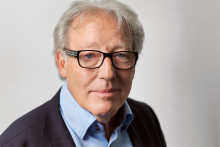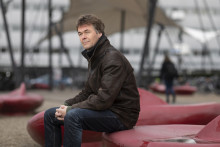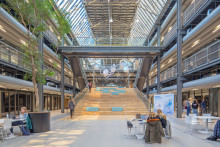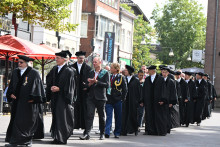It is 1983; Gerber is working with Gerd Binnig and Heinrich Rohrer, who would later be awarded a Nobel Prize, on the Scanning Tunnelling Microscope (STM) in the IBM research laboratory in Rüschlikon. There he becomes the first person to see a 3D representation of various atoms, using the self-built microscope. ‘A fantastic experience,’ he recalls. ‘More so, because we were often told it couldn’t be done. Our project was considered high risk from the start and, for that reason, I spent more than a year working practically alone and undercover on the microscope.’
And what makes the achievement even more exceptional is the successor to the STM: the Atomic Force Microscope (AFM). The STM was revolutionary but the AFM is used everywhere today and is one of the most important instruments for understanding the nano world. ‘The STM had its limitations,’ says Gerber. ‘We could only observe conducting surfaces. The AFM opened up a whole new world; we can see individual molecules but we can also see the chemical bonds and even manipulate them.’
Record player
The instrument works in a way that is not dissimilar to an old-fashioned record player. It has a long arm (the cantilever) with a fine tip at the end. On a record player, the stylus is vibrated by the grooves on a record and this is electronically amplified. On the AFM, the arm and the tip are so miniscule that the tip moves if it is attracted or repelled by individual atoms.
‘The record player was, indeed, an inspiration,’ Gerber admits. ‘The components we needed for the AFM were not yet commercially available, of course. The basis for the instrument was a thin arm, only a couple of micrometres wide, made from gold foil. We bought a pick-up stylus from a hi-fi shop, which we broke apart and glued tiny fragments on the gold foil. Five months later, we had a working system.’
The AFM, in all its different forms, is now used on a daily basis in laboratories all over the world. And this summer Gerber and his colleagues, Gerd Binnig and Calvin Quate, were awarded the Kavli Prize. ‘A wonderful honour, just like this honorary doctorate,’ says Gerber. ‘The Kavli Prize is the most prestigious award in our profession, almost equivalent to a Nobel Prize.’

Single Malt
Gerber enjoys telling the story with enthusiasm. We meet in his modest office at the Swiss Nanoscience Institute in Basel, where he is the scientific director. An unopened bottle of single-malt whisky stands before us; Laphroaig 10 Year Old, but the label is covered by a plastic bag from the shop. Following on from the pioneering days of the 1980s, he worked on an electronic ‘nose’, which could ‘smell’ different molecules ultra-sensitively. And this prompted him to train his own nose, but for savouring whisky.
He doesn’t take on the challenge of identifying the spirit by its aroma because, ‘it’s too early in the morning’. But it is immediately clear that this is his second passion and he does throw in a lecture on distilling and fermenting, maturing and malting. Scotland is a favourite holiday destination and he would definitely recognise this Islay whisky. ‘The aroma of peat betrays this single malt,’ he says. ‘During the maturing process in the casks, a portion of the distillate escapes; that’s the angels’ share for the environment.’
Personalised medicine
Atomic-force microscopy and the electronic nose are brought together in Gerber’s current research field. ‘We have combined the technologies in an instrument that can be used to diagnose skin cancer and particularly its most lethal variant, melanoma. At the genetic level, there are more than two hundred types of cancer. IF you can recognize them on the genetic level, better therapies and drugs can be developed that will lead to a faster and better cure. With 30 years of AFM technology behind us, we can now make a diagnosis in a single day. And with this we are entering the realm of personalised medicine: you can now treat the cancer cells individually.’
Gerber has become a biologist, as he puts it himself. He was brought up in Basel, where he was born in 1942, in neutral Switzerland. ‘My father worked in the pathology department of the university hospital,’ he says. ‘He actually worked in administration but from an early age we heard stories about the human body, bacteria in the body and viruses. One exhibition of human body parts made a deep impression on me: if I hid behind the human skeleton, I knew that my sister wouldn’t find me because she didn’t dare to look there.’
High-flyer
By his own admission, he was not yet a high-flyer. ‘I was more of a dreamer, school wasn’t my priority. Eventually, I ended up studying mechanical engineering and I started working for a Swiss company in Stockholm.’ The turning point in his life came in 1966, when he worked with Heinrich Rohrer, who would go on to be awarded a Nobel Prize, at the IBM laboratory in Rüschlikon.
‘A wonderful and stimulating environment,’ is how Gerber describes IBM. ‘At the time, the philosophy was: we’ll put the best people together and give them the freedom to do virtually what they like. Rohrer was a natural leader and a visionary; a fantastic inspirer.’ It was here that Gerber also worked with Gerd Binnig on the STM and AFM: ‘an absolute genius but also incredibly empathic and easy to be around.’
‘It was such a stimulating environment,’ says Gerber. ‘We invented things and found new ways to get results. And we made our own equipment. I still find it special; a lot of brain power and work were invested in the development of the AFM but the prototype itself cost less than 400 dollars.’ This is largely down to the philosophy of research labs such as IBM’s. ‘Put creative people together and give them a free hand,’ is how Gerber describes the culture. ‘We were able to focus on fundamental research. Today, the emphasis is more on applied research; it has to produce results.’

Academic world
Sporting brand Nike created a furore with its slogan just do it, but Gerber – as his surroundings illustrate – is the personification of this. ‘It’s an essential quality for a scientist,’ he says. ‘Certainly for young people at the beginning of their career. Don’t be afraid to floor the accelerator and bring your wildest dreams and ideas to life. Really, how many times have we heard that something can’t be done? This should only motivate you to push forward, even in adversity.’
That requires commitment, courage and perseverance. Sometimes they worked day and night at IBM. ‘I still remember vividly working on the AFM at Stanford in 1985. If we got stuck once again, we would play a round of golf at six in the morning, after which we would go back and take another look at the problem. That kind of attitude is a prerequisite to achieving results.’ Because science is mainly a process of trial and error. ‘It’s about seeing what happens if you turn a certain knob. If it doesn’t lead to anything, then at least you know it was a dead end. There are also lessons to be learned from that.’
Under the radar
Another lesson he likes to share is: make sure you always have a hidden agenda. ‘We never wrote down in a research proposal that we were working on the STM,’ Gerber explains. ‘Of course not! The project would never have been approved. Science has a political component. Make sure you have the resources to get started and show results.’ That’s the now 74-year-old Gerber in a nutshell. He still goes into the office two days a week, where he carries out research and has three papers in the pipeline. ‘I really should retire,’ he laughs. ‘But I prefer to continue working. A little under the radar. I will only retire if I think my work no longer has relevance, and that might be not for a while.’






